7 May 2024

On a sunny day in April 2023, 57-year-old Mike took off in his two-seater plane on an outing from an airfield in Upminster. After flying his passenger over Hanningfield Reservoir, they landed to refuel and prepare for another flight over Brands Hatch. But this second trip didn’t go as smoothly.
Once 300ft up in the sky it became clear there was an issue. The plane was lacking power and struggling to gain any more height: the engine had stopped and would not restart. With electricity pylons, an industrial estate and a busy road on the right and mere seconds to make a decision, Mike was forced to steer the now rapidly falling plane to the left, where it crashed through some trees and hit the ground.
Although fully alert and awake, Mike was trapped in the wreckage of the plane as well as being badly injured. Fortunately, his passenger was not, and she was able to dial 999. Given the nature of the incident, London’s Air Ambulance’s advanced trauma team was dispatched almost immediately.
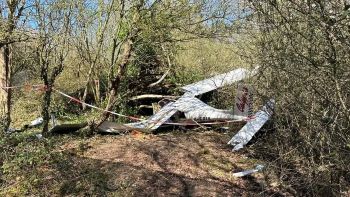
The plane had crashed in a wooded area which was very difficult for the other emergency services to initially locate. One of the advantages of the helicopter is the ability to have a bird’s eye view. Our team was quickly able to locate the crash site and from overhead see that there were no visible flames or smoke. They landed in an adjacent field and made their way through the woodlands to the scene. Our crew was the first emergency service to reach Mike and his passenger.
The team helped Mike’s passenger off the wreckage, creating more space to assess him. They identified he had likely broken quite a few ribs on the left side of his chest. This was causing him a lot of pain and compromising his breathing. Mike also had a badly broken left ankle. Crucially, Mike was conscious and able to tell the team he was on a blood-thinning drug.
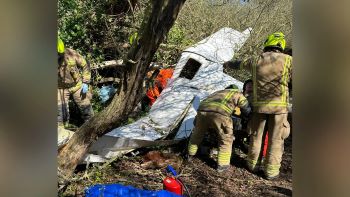
The team proceeded to give Mike painkillers in the form of a lollipop while they established intravenous access. A plan to extricate him was being made with the London Fire Brigade (LFB) and the London Ambulance Service Hazardous Area Response Team (LAS HART) who had now also arrived. The team sedated Mike to facilitate his extrication from the wreckage without causing him any pain.
Once out of the plane, Mike was carried to the field where the helicopter had landed. There, with the help of LAS paramedics, the team fully examined him whilst preparing to give him a general anaesthetic. The numerous broken ribs on his left side meant that Mike had lost the structural integrity of his chest, as well as suffered a collapsed lung – all of which was compromising his breathing. Once the general anaesthetic was complete, the team proceeded to perform a surgical procedure to the left side of his chest which released the trapped blood and air and allowed the lung to re-inflate. Mike was then placed on a mechanical ventilator. The team realigned his broken ankle to keep blood flow to his foot and applied a cast to his lower leg. Mike was then placed into the helicopter. On the way to hospital, the team gave him antibiotics and a drug to reverse the effect of the blood thinning drug he was taking.
As Mike was being taken to the nearest major trauma centre, his wife Jo was informed of the incident. “I was in Manchester at the time for work, so I had to catch the next train back to London,” said Jo.
“It was the most awful train journey I have ever had. The crash was being reported on in the news, using words like ‘life-changing’ and ‘life-critical injuries’.”
Jo arrived at the hospital late that evening, alongside Mike’s two daughters Charley and Michaela, but Mike was so unwell they couldn’t see him until much later. He remained in a coma for three weeks in the intensive care unit, before being moved to the high dependency unit and then on to the trauma ward.
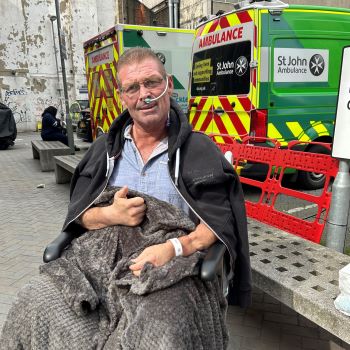
“Mike came home on 7 May and I’ve looked after him ever since,” said Jo. “At the beginning, he would have a lot of flashbacks from the incident and you’d see blind fear in his face. It was horrible.”
When Mike was discharged home, he was unable to sit up or walk due to the number of injuries to his chest, ribs and lungs. Jo became his full-time carer and helped him slowly build up his strength.
“Given what happened on that day, it is remarkable Mike is still here with us,” said Jo. “We owe Mike’s life to London’s Air Ambulance Charity and all the clinicians who looked after him in hospital. Without them it could so easily have been a different outcome.”
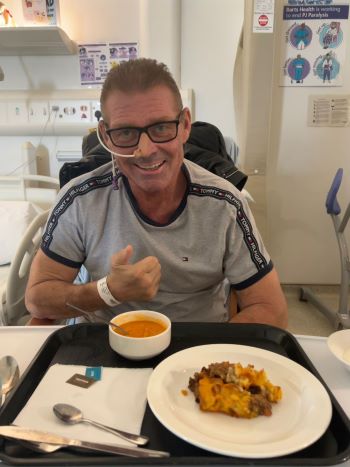
Mike is still living with the after-effects of the incident. As a result of the severe ankle injury, he has been diagnosed with avascular necrosis which causes him pain and requires regular hospital appointments and treatments. From being in a coma for such a significant amount of time, Mike also suffers from tiredness and lack of concentration. But he is home with Jo and his two daughters.
“He is a different Mike now. But he is still here, and I am so lucky,” said Jo.
“I can’t believe the service that saved him is a charity. It wouldn’t be here without support from the public. And Mike wouldn’t be here without it.”
Mike, Jo, Charley and Mike’s four grandsons have since visited London’s Air Ambulance’s helipad and met the team that helped Mike on that day.
Mike told us: “Although it was an extremely emotional day, it was very special to be able to show my grandsons the helicopter and introduce them to the team that saved my life. A day I will never forget.”
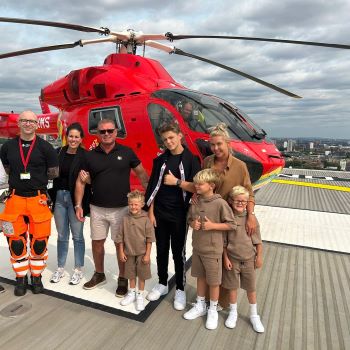
“The air ambulance service doesn’t stop after they deliver the patient to hospital, in our experience they were a constant source of support.
“They would appear on the bleakest of days and help us find the positives,” said Jo.
“To another wife going through this, I would say ‘ask questions’. It’s overwhelming and scary, but when you know what machine is doing what, when you know which drug is for what, it all feels a little more manageable. It takes some fear away knowing what is happening.
“We were also advised to keep a diary. I wasn’t overly keen on the idea initially, but it was actually so helpful. You can keep a record and look back on the progress you’ve made. We still look back on it now and see how far we’ve come.”
Mike said: “I have no idea what the future holds for me. There is still a long road for me to travel and I’m sure it will have lots of ups and downs. I do however have a future and for that I will forever be grateful.”

